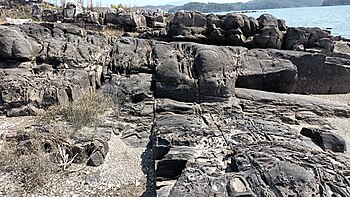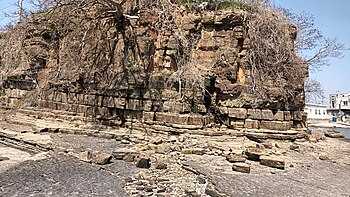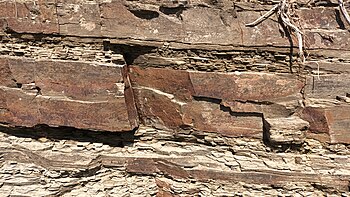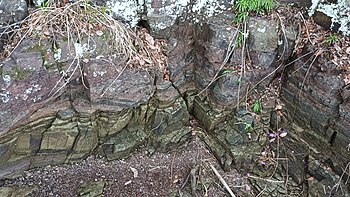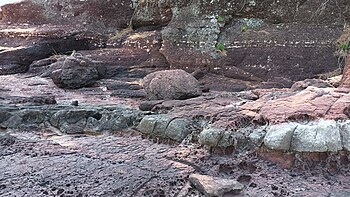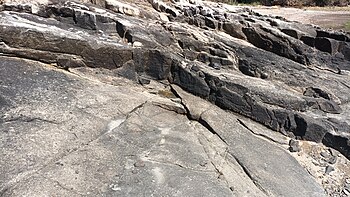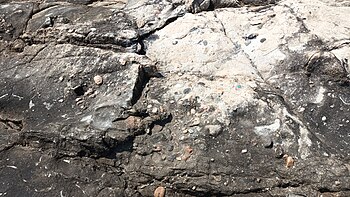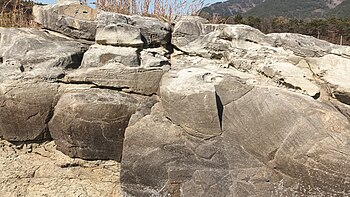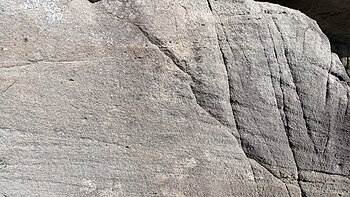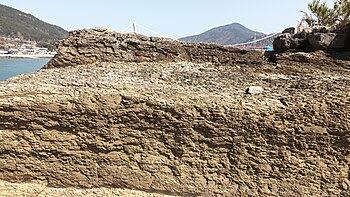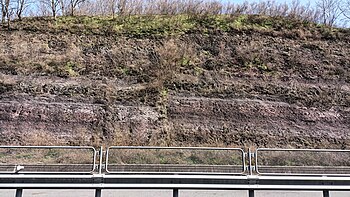Hasandong Formation
| Hasandong Formation | |
|---|---|
| Stratigraphic range: Aptian-Albian ~ | |
| Type | Geological formation |
| Unit of | Shindong Group |
| Underlies | Jinju Formation |
| Overlies | Nakdong Formation |
| Thickness | 1200 metres |
| Lithology | |
| Primary | Mudstone |
| Other | Shale, sandstone |
| Location | |
| Coordinates | 35°06′N 128°00′E / 35.1°N 128.0°E |
| Approximate paleocoordinates | 41°18′N 128°06′E / 41.3°N 128.1°E |
| Region | North Gyeongsang Province |
| Country | |
The Hasandong Formation (Korean: 하산동층; Hanja: 霞山洞層; RR: Hasandong-cheung) is an Early Cretaceous (Aptian to Albian) geologic formation in South Korea. It has been dated to the late Aptian and earliest Albian, between 118.0 ± 2.6 Ma and 112.4 ± 1.3 Ma.[1] Dinosaur remains diagnostic to the genus level are among the fossils that have been recovered from the formation.[2] Tracks of the pterosaur ichnospecies Pteraichnus koreanensis have also been recovered from the unit.[3]
Fossil content[edit]
Invertebrate fossils[edit]
Few fragments of insects have been discovered from the formation.[4]
Molluscs[edit]
| Molluscs reported from the Hasandong Formation[5] | ||||||
|---|---|---|---|---|---|---|
| Genus | Species | Location | Stratigraphic position | Material | Notes | Images |
| Plicatounio | P. naktongensis | |||||
| P. okjuni | ||||||
| P. yooni | ||||||
| Nagdongia | N. soni | |||||
| Trigonioides | T. jaehoi | |||||
| T. kodairai | ||||||
| T. tamurai | ||||||
| Brotiopsis | B. kobayashii | |||||
| B. naktongensis | ||||||
| B. ryohoriensis | ||||||
| B. wakinoensis | ||||||
| Viviparus[6] | V. sp. | Architaenioglossan gastropod, probably V. keishoensis | ||||
| Probaicalia | P. katoensis[7] | Hydrobiidae gastropod; species previously assigned to the genus Micromelania | ||||
Ostracods[edit]
Ostracod carapaces have been discovered from the formation.[4]
| Ostracods reported from the Hasandong Formation | ||||||
|---|---|---|---|---|---|---|
| Genus | Species | Location | Stratigraphic position | Material | Notes | Images |
| Cypridea | C. cf. trita[8][9] | |||||
Vertebrate fossils[edit]
Actinopterygii[edit]
| Ray-finned fish reported from the Hasandong Formation | ||||||
|---|---|---|---|---|---|---|
| Genus | Species | Location | Stratigraphic position | Material | Notes | Images |
| Sinamia[10] | S. sp. | Partial Skeleton | ||||
| Lepidotes[4] | L. sp. | Partial Skeleton | ||||
Testudines[edit]
Shell fragments of testudines have been discovered.
| Turtles reported from the Hasandong Formation | ||||||
|---|---|---|---|---|---|---|
| Genus | Species | Location | Stratigraphic position | Material | Notes | Images |
| Proadocus[11] | P. hadongensis | Partial Skeleton | Adocid turtle | |||
Crocodylomorpha[edit]
Several teeth remains have been reported but are not assigned to the specific clade.
| Crocodylomorphs reported from the Hasandong Formation | ||||||
|---|---|---|---|---|---|---|
| Genus | Species | Location | Stratigraphic position | Material | Notes | Images |
| "Hadongsuchus"[12] | "H. acerdentis" | Skull | nomen nudum | |||
Pterosaurs[edit]
| Pterosaurs reported from the Hasandong Formation | ||||||
|---|---|---|---|---|---|---|
| Genus | Species | Location | Stratigraphic position | Material | Notes | Images |
| Pterodactyloidea[13][14][15] | Indeterminate | Teeth and a partial second wing phalanx | Dental remains belong to either Boreopteridae or Anhanguerian | |||
| Dsungaripteridae[16] | Indeterminate | Incomplete wing phalanx | ||||
Dinosaurs[edit]
Several indeterminate theropod teeth remains have been reported.
| Dinosaurs reported from the Hasandong Formation | ||||||
|---|---|---|---|---|---|---|
| Genus | Species | Location | Stratigraphic position | Material | Notes | Images |
| Carcharodontosauridae | Indeterminate | Teeth | Some dental remains show similarities with Acrocanthosaurus | |||
| Hadrosauroidea | Indeterminate | Tooth | ||||
| Titanosauriformes[17][18] | Indeterminate | A partial skeleton and several teeth showing different morphotypes | Includes Chiayusaurus lacustris and Pukyongosaurus milleniumi, both of which are nomen dubium | |||
| Tyrannosauroidea[19] | Indeterminate | Tooth, estimated crown length ~18mm | ||||
Ichnofossils[edit]
Tracks of theropods, sauropods and ornithopods have been discovered from the formation.[4][20]
| Ichnofossils reported from the Hasandong Formation | ||||||
|---|---|---|---|---|---|---|
| Genus | Species | Location | Stratigraphic position | Material | Notes | Images |
| Pteraichnus[3] | P. koreaensis | Pterosaur tracks | ||||
| Sauripes[21] | S. hadongensis | The oldest lizard tracks showing bipedalism | ||||
| Diplocraterion[22] | D. luniforme | |||||
| Beaconites | B. coronus[20] | |||||
| Circulichnus | C. montanus[20] | |||||
| Cochlichnus | C. anguineus[20] | |||||
| Chondrites | C. isp.[20] | |||||
| Helminthopsis | H. abeli & H. hieroglyphica[20] | |||||
| Laevicyclus | L. isp.[20] | |||||
| Planolites | P. annularius, P. beverleyensis & P. montanus[20] | |||||
| Skolithos | S. magnus, S. verticalis & S. isp.[20] | |||||
| Spirodesmos | S. isp.[20] | |||||
| Taenidium | T. barretti[20] | |||||
| Thalassinoides | T. paradoxicus & T. suevicus[20] | |||||
Eggs[edit]
Unnamed dinosaur egg fossils have been reported.
| Eggs reported from the Hasandong Formation | ||||||
|---|---|---|---|---|---|---|
| Genus | Species | Location | Stratigraphic position | Material | Notes | Images |
| Testudoolithus[4] | T. aff. curiosa | Turtle eggs | ||||
Paleoflora[edit]
Consists of 6 genera and 9 species. The assemblage of plant fossils from the Hasandong represents the 'mixed' type of Tetori-type and Ryoseki-type flora.
| Plants reported from the Hasandong Formation[23] | ||||||
|---|---|---|---|---|---|---|
| Genus | Species | Location | Stratigraphic position | Material | Notes | Images |
| Brachyphyllum | B. japonicum | Araucariaceae conifer | ||||
| Cladophlebis | C. denticulata | |||||
| C. (Eboracia?) lobifolia | ||||||
| C. (Klukia?) koraiensis | ||||||
| C. shinshuensis | ||||||
| Elatocladus | E. tennerima | Conifer with an unknown systematic position | ||||
| Onychiopsis | O. elongata | Leptosporangiate fern | ||||
| Taeniopteris | T.? sp. cf. T. auriculata | The specific systematic position of this form genus is unknown. | ||||
| Thallites | T. yabei | Liverwort | ||||
Photo[edit]
-
Normal Faults 34°59′59.6″N 127°55′08.1″E / 34.999889°N 127.918917°E
-
Corss-bedding 34°56′50.9″N 127°51′08.5″E / 34.947472°N 127.852361°E
-
Corss-bedding 34°56′50.9″N 127°51′08.5″E / 34.947472°N 127.852361°E
-
Corss-bedding 34°56′51.0″N 127°51′08.7″E / 34.947500°N 127.852417°E
See also[edit]
References[edit]
- ^ Lee, Tae-Ho; Park, Kye-Hun; Yi, Keewook (October 2018). "Nature and evolution of the Cretaceous basins in the eastern margin of Eurasia: A case study of the Gyeongsang Basin, SE Korea". Journal of Asian Earth Sciences. 166: 19–31. Bibcode:2018JAESc.166...19L. doi:10.1016/j.jseaes.2018.07.004. S2CID 135061525.
- ^ Weishampel, David B.; Barrett, Paul M.; Coria, Rodolfo A.; Le Loueff, Jean; Xu, Xing; Zhao, Xijin; Sahni, Ashok; Gomani, Emily M.P.; Noto, Christopher N. (2004). "Dinosaur distribution". In Weishampel, David B.; Dodson, Peter; Osmólska, Halszka (eds.). The Dinosauria (Second ed.). Berkeley: University of California Press. pp. 517–607. ISBN 978-0-520-24209-8.
- ^ a b Y.-N. Lee, H.-J. Lee, J. and Y. Kobayashi. 2008. New pterosaur tracks from the Hasandong Formation (Lower Cretaceous) of Hadong County, South Korea. Cretaceous Research 29:345-353.
- ^ a b c d e Choi, S.; Kim, H.; Paik, I.; Park, Y.; Jung, H.; Xu, X. (2023). "Turtle eggs from the Lower Cretaceous Hasandong Formation (South Korea) with relict aragonite under significant thermal maturity". Journal of Vertebrate Paleontology. 42 (4). e2183866. doi:10.1080/02724634.2023.2183866.
- ^ Kim, Jeong Yul; Huh, Min (2018). Dinosaurs, Birds, and Pterosaurs of Korea: A Paradise of Mesozoic Vertebrates (PDF). Springer Nature. ISBN 978-981-10-6998-7.
- ^ Yun, Cheol-Soo; Yang, Seung-Yeong (2001). "Cretaceous Non-marine Molluscan Fauna From the Euiseong Subbasin in Korea". Journal of the Paleontological Society of Korea. 17 (1): 1–14 – via DBpia.
- ^ Isaji, S. (2023). "Molluscan Faunal Changes from Brackish to Freshwater Deposits in the Lower Cretaceous Itsuki Formation of the Tetori Group, Japan". Paleontological Research. 28 (1): 1–25. doi:10.2517/PR220022. S2CID 257962930.
- ^ Hayashi, K. (2006). "Nonmarine ostracode zonation and long-distance correlation based on analysis of regional ostracode successions in China, Korea, Japan, and Mongolia". Cretaceous Research. 27 (2): 168–188. doi:10.1016/j.cretres.2005.11.007.
- ^ Qin, Z.-H.; Xi, D.-P.; Choi, B.-D.; Ye, Y.-Q.; Wan, X.-Q. (2021). "Lowermost occurrence of ostracod Cypridea species in East Asia and implications for the non-marine Jurassic/Cretaceous boundary". Palaeoworld. 30 (1): 148–168. doi:10.1016/j.palwor.2020.04.003.
- ^ Yabumoto, Y.; Yang, S.Y.; Kim, T.W. (2006). "Early Cretaceous freshwater fishes from Japan and Korea" (PDF). Journal of the Paleontological Society of Korea. 22 (1): 119–132.
- ^ Kim, D. H.; Lee, Y.-N.; Ko, H.; Park, J.-Y.; Kim, S.-H.; Lee, S.; Jung, S.-H.; Kong, D.-Y. (2023). "The first adocid turtle in South Korea (Lower Cretaceous) and the early evolution of the Adocidae". Cretaceous Research. 105665. doi:10.1016/j.cretres.2023.105665.
- ^ Lee, Hang-Jae. A New Protosuchian (Archosauria: Crocodyliformes) Skull from the Hasandong Formation (Lower Cretaceous) of Hadong, Korea. Master's thesis, Chungnam National University, 2005.
- ^ Park, J.-Y.; Lee, S.; Kim, S.-H.; Son, M.; Lee, Y.-N. (2020). "A pterosaur wing phalanx from the Lower Cretaceous Hasandong Formation of Hadong-gun, Gyeongsangnam-do, South Korea" 경상남도 하동군 하부 백악기 하산동층에서 산출된 익룡 지골 화석 [A pterosaur wing phalanx from the Lower Cretaceous Hasandong Formation of Hadong-gun, Gyeongsangnam-do, South Korea] (PDF). Journal of the Geological Society of Korea. 56 (1): 77–84. doi:10.14770/jgsk.2020.56.1.77. S2CID 216159474.
- ^ Yun, Chan-Gyu (2021). "Boreopterid pterosaur fossils from South Korea reconsidered". New Mexico Museum of Natural History and Science Bulletin. 82: 567–568.
- ^ Yun, Chan-Gyu (2024). "Geometric morphometric approach to establish phylogenetic affinities of enigmatic pterosaur specimens from the Lower Cretaceous of South Korea". Acta Palaeontologica Romaniae. 20 (1): 77–86. doi:10.35463/j.apr.2024.01.06.
- ^ Lim, Jong-Deock; Baek, Kwang-Seok; Yang, Seung Young (2002). "A new record of a pterosaur from the Early Cretaceous of Korea". Current Science. 82 (10): 1208–1210. JSTOR 24107042.
- ^ Z. Dong, I. S. Paik, and H. J. Kim. 2001. A preliminary report on a sauropod from the Hasandong Formation (Lower Cretaceous), Korea. In T. Deng, Y. Wang (eds.), Proceedings of the Eighth Annual Meeting of the Chinese Society of Vertebrate Paleontology 41-53.
- ^ Choi, Seung; Lee, Yuong-Nam (2017-12-01). "A review of vertebrate body fossils from the Korean Peninsula and perspectives". Geosciences Journal. 21 (6): 867–889. doi:10.1007/s12303-017-0040-6. ISSN 1598-7477.
- ^ Lee, Yuong-Nam (2008-03-01). "The first tyrannosauroid tooth from Korea". Geosciences Journal. 12 (1): 19–24. doi:10.1007/s12303-008-0003-z. ISSN 1598-7477.
- ^ a b c d e f g h i j k l Kim, J.Y.; Pickerill, R. (2002). "Cretaceous Nonmarine Trace Fossils from the Hasandong and Jinju Formations of the Namhae Area, Kyongsangnamdo, Southeast Korea". Ichnos. 9 (1–2): 41–60. doi:10.1080/10420940190034076.
- ^ Lee, H.J.; Lee, Y.N.; Fiorillo, A.R.; Lü, J. (2018). "Lizards ran bipedally 110 million years ago". Scientific Reports. 8 (1): 2617. Bibcode:2018NatSR...8.2617L. doi:10.1038/s41598-018-20809-z. PMC 5814403. PMID 29449576.
- ^ J.-Y., Kim; I. S., Paik (1997). "Nonmarine Diplocraterion luniforme (Blanckenhorn 1916) from the Hasandong Formation (Cretaceous) of the Jinju area, Korea". Ichnos. 5 (2): 131–138. doi:10.1080/10420949709386412.
- ^ Kim, Jong-Heon; Nam, Kye-Soo; Lee, Seong-Bok; Jeon, Yeong-Seok (2016). "Fossil Plants from the Early Cretaceous Hasandong Formation of Chilgok Area, Korea" (PDF). Journal of the Korean Earth Science Society. 37 (5): 295−308. doi:10.5467/JKESS.2016.37.5.295.
Bibliography[edit]
- Weishampel, David B.; Peter Dodson, and Halszka Osmólska (eds.). 2004. The Dinosauria, 2nd edition, 1–880. Berkeley: University of California Press. Accessed 2019-02-21. ISBN 0-520-24209-2


